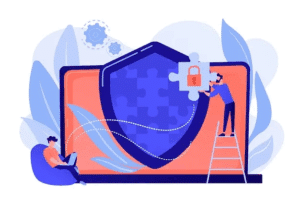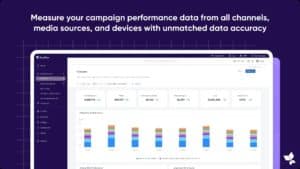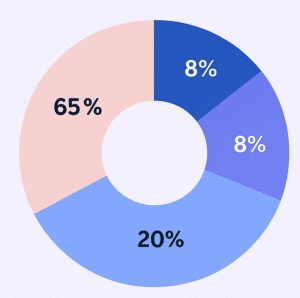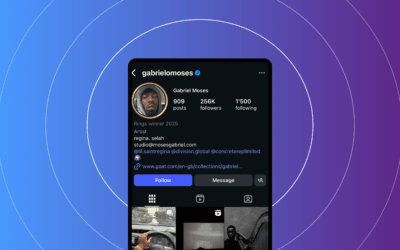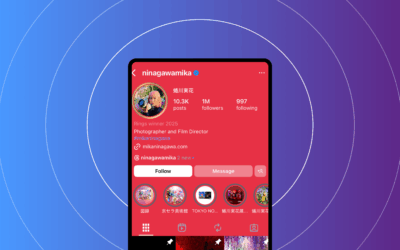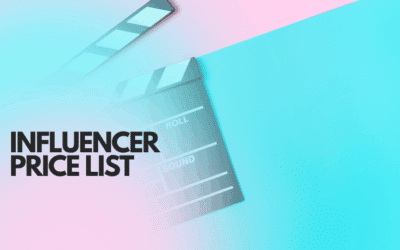Marketing d'influence pour les jeux mobiles : Le guide définitif pour 2026
Les vidéos de courte durée et la découverte par les créateurs déterminent la manière dont les joueurs découvrent de nouveaux jeux, tandis que les campagnes mesurées prouvent qu'il est possible d'améliorer la qualité des jeux. ROI au-delà des mesures de vanité.
Pour en savoir plus sur les téléchargements, les dépenses et les tendances régionales, consultez les rapports de marché de data.ai insights hub et de Sensor Tower ; Think with Google suit également les données suivantes comment les créateurs influencent le comportement d'achat dans les jeux.
En 2025, l'attribution par mobile les partenaires de mesure (MMP) est plus accessible que jamais, ce qui vous permet de mesurer les installations, les événements in-app, et les ROAS en toute confiance.
Ce guide propose une définition claire, des étapes de planification, des formats créatifs, des mesures, une gouvernance, des outils, des budgets et des exemples concrets. Vous verrez également comment le marketing des jeux mobiles s'articule avec le contenu des créateurs pour augmenter le nombre d'installations, la fidélisation et l'efficacité des jeux. monétisation.
Qu'est-ce que le marketing d'influence pour les jeux mobiles ?
Le marketing d'influence des jeux mobiles est une axé sur la performance stratégie qui utilise créateurs-Les joueurs de jeux vidéo, les YouTubers, les TikTokers et les personnalités du monde du sport peuvent ainsi augmenter le nombre de joueurs d'un jeu. base et des recettes.
Il ne s'agit pas d'une vague prise de conscience. Il s'agit de résultats mesurables : installations, fidélisation, monétisation et expansion de la communauté.
Comment cela fonctionne-t-il en pratique ?
Les marques collaborent avec les créateurs par le biais de plusieurs niveaux tactiques :
-
Parrainages rémunérés - des intégrations ponctuelles, des mentions en milieu de défilement ou des vidéos dédiées qui génèrent un trafic immédiat.
-
Ambassades à long terme - des campagnes saisonnières avec un contenu récurrent qui cible la rétention et le LTV.
-
Codes d'affiliation ou de référence - des liens uniques qui suivent les installations et récompensent les joueurs.
-
Les semis de l'UGC - en donnant aux créateurs un accès anticipé ou des actifs exclusifs pour susciter un engouement organique.
-
Événements co-créés dans le jeu - des défis de marque ou des offres à durée limitée qui renforcent l'engagement.
Qu'est-ce qui le différencie du marketing général des créateurs ?
Les campagnes de jeux mobiles se concentrent sur conversion et rétention plutôt qu'une simple visibilité. La performance est mesurée par installe, événements in-app, taux de rétention, ARPDAUet ROAS-et pas seulement des impressions.
Les créatifs s'appuient sur démonstrations de gameplay, conseilset défis en direct plutôt que des placements génériques de style de vie.
Paramètres et termes clés
Le langage commun de ces campagnes est le suivant UGC, codes d'affiliation, codes promotionnelset MMPs comme AppsFlyer et Ajuster. Des mesures telles que IPC, CAC, LTV, ARPDAUet ROAS définir le succès.
Des formats qui ont de l'impact
Les vidéos de première impression, les playthroughs complets, les streams en direct, les Shorts and Reels, les compilations de faits marquants et les code drops sont tous efficaces lorsqu'ils sont associés aux bons créateurs.
Les contenus de courte durée sont devenus le principal canal de découverte des titres mobiles, et les voix de confiance peuvent faire passer rapidement les joueurs du stade de la découverte à celui de l'installation.
En bref, le marketing d'influence des jeux mobiles transforme la portée des créateurs en une croissance directe et traçable pour les éditeurs de jeux.
Comment planifier des campagnes de marketing d'influence pour les jeux mobiles
Démarrage rapide de l'extrait vedette (8 étapes) :
- Définir les objectifs et les indicateurs de performance clés
- Comprendre le public et les personas des joueurs
- Sélectionner les niveaux d'influence
- Choisir des formats de campagne et rédiger des mémoires
- Définir des lignes directrices créatives et des règles de sécurité pour la marque
- Configurer le suivi et l'attribution
- Assurer la conformité et la divulgation
- Fixer un budget et un calendrier, piloter puis étendre
Étape 1 - Définir les objectifs et les indicateurs de performance clés
Commencez par aligner objectifs commerciaux avec des résultats mesurables. Les objectifs typiques sont les suivants installations (CPI), Jour 1/7/30 rétention, croissance DAU/MAUMonétisation précoce (ARPDAU), LTV, ROASet des mesures d'engagement telles que surveiller l'heure et CTR.
Conseil: Verrouillez les définitions dès le début afin que les créateurs sachent à quoi ressemble le succès.
Étape 2 - Comprendre le public et les profils des joueurs
Construire 3-4 archétypes de joueurs et de faire correspondre les créateurs à ces derniers. Exemples de groupes : joueurs mobiles occasionnels, joueurs de puzzle/stratégie de niveau moyen et joueurs compétitifs acharnés. Différences régionales (APAC vs NA/EMEA) affectent également le format et le calendrier.
Pour un contexte plus approfondi, voir les études d'audience basées sur les données dans nos articles précédents.
Étape 3 - Sélection des niveaux d'influence et justification
Mélange micro (10k-100k), macro (100k-1M)et méga créateurs pour la portée et la profondeur. Les micro-créateurs offrent souvent un engagement plus élevé par impression et un meilleur rapport coût-efficacité, ce qui est idéal pour tests de rétention.
Voir notre analyse approfondie : Qu'est-ce qu'un micro-influenceur ?
Étape 4 - Formats de campagne et briefing créatif
Créer un environnement clair slip avec les objectifs, les produits à livrer, les actifs, le ton et les CTA. Inclure droits d'utilisation et divulgations. Un exemple de dossier peut comprendre deux teasers courts, un présentation longue duréeet trois messages de la communauté avec un code de référence.
Étape 5 - Lignes directrices créatives et sécurité de la marque
Permettre aux créateurs d'être libres à l'intérieur glissières de sécurité. Assurer un emplacement de choix pour le logo, IU lisibleet les classements appropriés.
Pour obtenir des ressources sur la sécurité des marques, consultez notre liste de contrôle pratique.
Étape 6 - Suivi et attribution
Mettre en place un MMP (AppsFlyer ou Adjust) et créez liens uniques par créateur avec les UTM. Ajouter codes de référence/promo pour éviter les redondances. Suivre les étapes de l'entonnoir de installe à Recettes du jour 7/30.
Étape 7 - Conformité et divulgation
Les divulgations doivent être explicites : "#ad" ou "Sponsorisé par [Jeu]" dans les descriptions ; divulgations verbales sur les vidéos ; utilisation de la technologie de l'information et de la communication. orientations spécifiques aux plates-formes.
Voir les guides d'approbation de la FTC pour plus de détails.
Étape 8 - Établissement du budget et du calendrier
Pilotez d'abord, puis passez à l'échelle supérieure. Exemple pilote : 5 à 10 micro-créateurs pendant 2 à 4 semaines.
Les budgets typiques allouent 60-75% pour les frais de création, 20-30% à l'amplification payanteet 5-10%. Un échantillon Plan de 8 semaines s'exécute à partir de de la signature du contrat à l'autopsie et au détartrage.
Formats et plateformes de campagne
Choisir formats et canaux pour correspondre intention et public.
Contenus courts excelle sur TikTok, Reels, et Youtube Shorts pour installation rapide, tandis que long-form Vidéos YouTube soutenir la rétention par le biais de tutoriels et de récits de progrès.
Flux en direct (Twitch, YouTube Live) s'intensifient obligations communautaires pendant événements et lancements.
Orientation plateforme par plateforme :
- YouTube : les meilleurs pour la profondeur du jeu, le contenu épisodique et la fidélisation.
- Twitch : événements en direct, tournois, questions-réponses en temps réel.
- TikTok : découverte rapide, accroche dans les 2 ou 3 premières secondes, potentiel viral.
- Vidéos et histoires sur Instagram : une portée multiplateforme et des rappels en milieu d'entonnoir.
- Autres canaux : X/Twitter et Snapchat pour des mises à jour rapides, des annonces et des codes.
Guidage de la cadence d'ordonnancement :
Lancer le contenu dans un Fenêtre de 7 à 10 jours à maximiser la preuve socialepuis poursuivre en Semaine 2 et Semaine 4 à maintenir l'élan. Pour les tendances macro-canal, voir Insider Intelligence et les études de Nielsen référencées dans nos sources externes.
Métriques, mesures et retour sur investissement
Le retour sur investissement des campagnes d'influence = revenus attribuables / dépenses de campagne.
Dans le domaine de la téléphonie mobile, les équipes rapportent généralement ROAS à 7, 30 et 90 jours.
Principaux indicateurs :
- S'installe : comptabilisée par votre MMP ; répartie par créateur et par plateforme.
- IPC : dépenses totales / installations attribuées.
- Rétention : Jour 1, jour 7, jour 30. Mesuré par les sessions de retour ou les événements de fin de tutorat.
- ARPDAU : revenu journalier / DAU ; suivi par pays/cohorte.
- LTV : le revenu total par utilisateur sur 30/90 jours.
- ROAS : les recettes attribuées / les dépenses ; surveiller les signaux précoces au jour 7 et la récupération finale au jour 30/90.
- Engagement : temps de veille, CTR des liens, commentaires ; utilisés pour diagnostiquer la qualité de la création.
Les étapes de l'attribution (prêt à l'emploi) :
- Générer UTM uniques et codes promotionnels par créateur.
- Intégrez votre MMP (AppsFlyer ou Adjust) pour capturer les installations et les événements.
- Alimentation événements générateurs de recettes à la MMP pour ROAS/LTV Calculs.
- Utiliser des groupes de contrôle pour estimer incrémentalité.
Cadence du tableau de bord :
– Hebdomadaire : dépenses, installations, CPI par créateur ; noter les apprentissages créatifs.
– Tous les quinze jours : Instantané de rétention au 7e jour par rapport à la ligne de base.
– Mensuel : LTV et ROAS à 30 jours ; identifier les meilleurs créateurs pour le renouvellement.
Instantané fictif (exemple) :
- Dépenser $20,000 → 4,000 installe → CPI $5.
– Jour 7 rétention : 18% vs 10% ligne de base.
– LTV à 30 jours : $3.00 → ROAS à 30 jours = ($3 × 4 000) / $20 000 = 60%.
Sources : AppsFlyer attribution best practices ; Adjust measurement guidance (tous deux consultés en septembre 2025).
Gouvernance, considérations juridiques et éthiques
Les bases de la conformité que vous devriez intégrer dans chaque bref et contrat :
- Informations communiquées par la FTC : utiliser des étiquettes claires telles que "#ad", "Partenariat rémunéré" et des divulgations verbales au début des vidéos. Voir les guides d'approbation de la FTC pour plus de détails.
- Politiques de la plate-forme : suivre les règles de contenu de marque et les centres d'aide de chaque plateforme pour les mises à jour.
- Publicité adaptée à l'âge : éviter de pousser les utilisateurs mineurs à dépenser ou à faire de fausses déclarations de cotes.
- Confidentialité des données : s'appuient sur des événements in-app et des mécanismes de promotion approuvés par la plateforme plutôt que de collecter des données personnelles directement auprès des créateurs.
Liste de contrôle rapide sur la sécurité des marques :
- Pré-approbation des créateurs les 30 derniers posts/streams.
- Exclure créateurs dont le contenu est préjudiciable.
- Disposer d'un plan de crise avec des réponses approuvées.
Sources : Guides d'approbation de la FTC ; Sécurité des marques dans le marketing d'influence : A Practical Checklist ; Whitelisting guide for content teams.
Études de cas et exemples concrets
Réfléchir avec Google conserve des études de cas sur découverte axée sur le créateur et comment séquençage multi-plateforme affecte la conversion.
Ces exemples peuvent guider stimulation de l'activation et crochets créatifs (Réfléchir avec Google gaming insights, septembre 2025).
Un exemple anonyme (fictif) :
- Problème : Un puzzle RPG a cherché à accélérer les installations et à améliorer la rétention du jour 7 avant une mise à jour du contenu.
- Stratégie : Cohorte mixte de 8 micro-créateurs et de 2 macro-créateurs sur YouTube et TikTok ; les briefings étaient axés sur les "10 premières minutes + les 3 meilleurs conseils", avec des codes de créateur débloquant un pack de démarrage.
- Exécution : Pilote de 2 semaines, 12 vidéos en format court, 4 épisodes en format long, 2 flux de questions-réponses en direct. UTMs + MMP tracking + promo-code redemptions.
- KPIs et résultats : CPI $3.80 (objectif ≤ $4.00), rétention à J7 20% (+6 pts vs baseline), ROAS à 30 jours 72% (en voie de récupération à 90 jours).
- À retenir : Les accroches de type "tip-forward" sont plus performantes que les intros de type "hype" ; les "early-code drops" augmentent le CTR ; les "macro anchors" étendent la portée tandis que les "micro creators" favorisent la rétention.
Outils et technologie
Catégories à prendre en compte lors de l'élaboration de votre pile :
- Découverte et sensibilisation : les places de marché pour les créateurs, les réseaux d'agences et les outils propres aux plateformes (TikTok Creator Marketplace, YouTube BrandConnect).
- Attribution et mesure : AppsFlyer, Adjust et SDK de sécurité pour l'installation et le suivi des événements.
- Examen créatif et droits : stockage en nuage avec approbation et suivi des droits d'utilisation.
- Détection de la fraude : Les suites de fraude MMP ou les audits de tiers pour signaler les anomalies.
- Intégration du direct/streaming : Outils de coordination des campagnes en direct et de suivi l'engagement sur toutes les plateformes.
Liste de contrôle de l'outillage interne et de l'intégration de l'ingénierie :
– Mise en œuvre des SDK MMP et vérifier les événements in-app.
– Mise en place génération d'un code promo et le suivi des remboursements.
– Garantir examen de la protection de la vie privée et flux de consentement sont en place.
– Adopter a convention de dénomination des UTM et ID de campagne.
Budgétisation et planification pilote
Exemple de budget (fictif) :
- Total : $100,000
- Honoraires du créateur : $65,000
- UA payante/liste blanche : $20,000
- Production créative : $8,000
- Eventualité : $7,000
Plan pilote : 8-12 micro-créateurs sur 2-4 semaines pour identifier les gagnants par l'IPC et la rétention au 7e jour.
Les outils de retour sur investissement rapide comprennent
IPC = dépenses ÷ installations.
Recettes prévues = installations × conversion du payeur × valeur d'achat moyenne
ROAS = recettes ÷ dépenses.
Pièges courants
- S'appuyer sur la seule portée-Privilégier l'engagement et les performances passées avec les jeux.
- Mauvaise configuration du suivi-S'assurer que les MMP, les UTM et les codes sont en place avant de lancer une campagne de sensibilisation.
- Pas de tests créatifs-Testez d'abord les accroches et les formats avec de petites cohortes.
- Ignorer les divulgations-Intégrer des dispositions claires en matière de divulgation dans les mémoires et les contrats ; examiner le contenu lors des approbations.
- Activations ponctuelles-planifier une séquence de contenu de 30 jours avec des suivis aux semaines 2 et 4.
- Localisation manquante-utiliser les créateurs et les atouts locaux pour les marchés clés.
- Ne pas négocier les droits d'utilisationinclure les conditions de licence pour la durée, les plates-formes et l'amplification.
- Pas d'éventualité de fraude-Le budget de réserve et l'examen hebdomadaire des anomalies.
Sources : meilleures pratiques générales en matière de marketing d'influence et orientations en matière de gestion des risques (références internes et références 2025).
Tendances futures du marketing d'influence pour les jeux mobiles
- Vélocité de la forme courte : des cycles de création plus rapides et la découverte via Shorts/Reels/TikTok ; les créateurs restent essentiels pour l'agriculture urbaine.
- Commerce en direct et pourboires : les flux en direct fusionnent le divertissement et la conversion avec de nouvelles superpositions d'achats.
- Co-développement avec le créateur : Les skins, les quêtes et les cartes en jeu, conçus en collaboration avec les créateurs, renforcent les liens de la communauté.
- Création assistée par l'IA : les outils génératifs accélèrent la production de scripts, de sous-titres et de clips pour un plus grand nombre de crochets par semaine.
- Amélioration des mesures : Les tests d'attribution et d'incrémentalité, qui respectent la vie privée, normaliseront les rapports sur le retour sur investissement.
Pour connaître les tendances, consultez nos stratégies de marketing d'influence pour la référence 2025.
Conclusion
Marketing d'influence pour les jeux mobiles est devenu un canal de croissance mesurable et évolutif. Avec des objectifs clairs, des créateurs alignés sur l'audience, un suivi solide des MMP et une budgétisation disciplinée, vous pouvez aller au-delà des mesures de vanité pour installations, rétention, LTV et ROAS vous pouvez faire confiance.
Utilisez ce guide pour planifier un projet piloteLes partenariats avec les créateurs et les formats de jeux mobiles sont une source d'inspiration pour les entreprises, qui apprennent rapidement et développent les créateurs et les formats qui répondent à leurs attentes. Considérez les partenariats avec les créateurs comme un pilier de votre marketing de jeux mobiles, ancré dans les données, la créativité authentique et la valeur communautaire à long terme.
Pour connaître les tendances actuelles, consultez notre guide : Stratégies de marketing d'influence pour 2025 (IA, 4 M, exemple).
FAQ
Comment faire du marketing d'influence pour les jeux mobiles ?
Définir les objectifs, choisir les bonnes plates-formes et les bons créateurs, briefer les créatifs avec des experts. les UTM et les codes permettant le suivide mener un projet pilote, de mesurer CPI/rétention/LTV à l'aide d'une MMP et d'optimiser les meilleurs résultats.Liste de contrôle rapide : définir les indicateurs clés de performance → cartographier l'audience → présélectionner les créateurs → mettre en place un MMP + UTMs/codes → lancer un projet pilote → faire passer les gagnants à l'échelle.
Qu'est-ce que le marketing d'influence pour les jeux mobiles ?
C'est le utilisation stratégique des créateurs Vous êtes en charge de l'installation, de la fidélisation, de la monétisation et de la croissance de la communauté pour les jeux mobiles. Vous mesurez le CPI, la rétention au 7e jour, le LTV et le ROAS, et pas seulement les vues.
Comment mesurer le retour sur investissement des campagnes d'influence sur les jeux mobiles ?
Suivre les installations et les événements in-app par le biais d'une MMPpuis calculer ROAS: recettes attribuées à la campagne divisées par les dépenses. Couche en IPC et rétention (jour 1/7/30) et 30/90 jours LTV pour comprendre le retour sur investissement et la valeur.Pour mesurer les campagnes d'installation d'applications, voir Mesurer les campagnes d'installation d'applications : Des UTM aux MMP.
Quelles sont les meilleures plateformes pour le marketing d'influence des jeux mobiles ?
YouTube et Twitch exceller dans la profondeur du jeu et la mémorisation ; TikTok et bobines favoriser une découverte rapide. Choisissez en fonction de votre publicLes mécanismes de découverte des plates-formes sont multiples et diversifiés : format (en direct ou édité).
Comment identifier les bons influenceurs pour un jeu mobile ?
Vérifier l'adéquation avec le public par âge et par région, taux d'engagementla pertinence du contenu résultats des jeux précédents; effectuer des contrôles anti-fraude et s'assurer de la volonté d'utiliser les codes de suivi. Donnez la priorité aux créateurs dont le public joue réellement à votre genre de jeu.
Quel budget dois-je allouer aux campagnes d'influence sur les jeux mobiles ?
Commencez par un 10-20% pilotepuis les gagnants de l'échelle. Les honoraires des créateurs varient en fonction du niveau et du marché. IPC et ROAS objectifs pour éviter les dépenses excessives.
Quelles sont les règles juridiques applicables au marketing d'influence des jeux mobiles ?
Utilisez des divulgations claires et suivez les guides d'approbation de la FTC ; divulguez-les verbalement en direct/vidéo vers le début. Respectez également les politiques des plateformes et veillez à ce que les messages soient adaptés à l'âge des utilisateurs.
Sources : Guides d'approbation de la FTC ; politiques des plateformes ; références en matière de stratégie de marketing d'influence (septembre 2025).
Références externes (pour la CMS ; un lien par source ; consulté en septembre 2025) :
- Blog de la TOUR DE SENSOR (données régionales)
- Statista : les jeux mobiles
- Réfléchir avec Google gaming insights
- Ressources AppsFlyer
- Ajuster les ressources
- Rapport de référence sur le marketing d'influence (2025)
- Couverture par Insider Intelligence
- Les perspectives des médias numériques de Nielsen
- Académie des créateurs YouTube
- TikTok pour les entreprises
- Conseils sur le marketing d'influence Meta
- Centre des créateurs d'Instagram
- Guide de la liste blanche pour les équipes chargées du contenu
Autres articles intéressants :
- Qu'est-ce qu'un micro-influenceur ? - apprendre pourquoi les micro-créateurs sont souvent à l'origine d'une forte rétention dans les jeux.
- Mesurer les campagnes d'installation d'applications : Des UTM aux MMP - ce qu'il faut mesurer et comment.
- La sécurité des marques dans le marketing d'influence : Liste de contrôle pratique - des garde-fous pour les partenariats.
- Qu'est-ce que la liste blanche ? Un guide pratique pour les équipes chargées du contenu en 2025 - les droits sur le contenu et l'amplification.
- Stratégies de marketing d'influence pour 2025 : IA, 4 M, Exemple - des idées stratégiques pour cette année.
Articles sur le marketing d'influence
Des conseils pratiques pour mieux réussir ses campagnes de marketing d'influence
Qui est Gabriel Moses ?
Découvrez Gabriel Moses, l'artiste né à Londres qui mêle mode, musique et patrimoine dans des récits visuels saisissants. De Dior à Johnnie Walker, voyez pourquoi il façonne la culture.
Qui est Mika Ninagawa ?
Découvrez Mika Ninagawa, photographe et réalisatrice visionnaire de Tokyo célébrée pour son art vif, ses récits audacieux, et gagnez à Instagram Rings 2025.
Liste de prix des influenceurs : Ce que les marques paieront en 2025 et 2026
Une liste de prix pour les influenceurs est un ensemble de tarifs et de conditions que les créateurs (ou leurs agents) fournissent - la base pour budgétiser, négocier et prévoir les campagnes d'influence.








